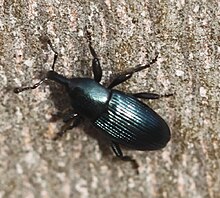Cress weevil
| Cress weevil | ||||||||||||
|---|---|---|---|---|---|---|---|---|---|---|---|---|

Cress weevil ( Aulacobaris lepidii ) |
||||||||||||
| Systematics | ||||||||||||
|
||||||||||||
| Scientific name | ||||||||||||
| Aulacobaris lepidii | ||||||||||||
| ( Germar , 1824) |
The cress tooth weevil ( Aulacobaris lepidii ) is a beetle from the family of the weevils (Curculionidae). The species was first described by Ernst Friedrich Germar in 1824 as Baris lepidii .
description
The beetles are 2.8-4 mm long (measured from the front edge of the eyes to the rear end of the wing covers ). The beetles are colored dark blue or green blue. The elytra are expanded almost straight from the base to the rear. The maximum width is approximately at the end of the front third. A shoulder bump is only hinted at. The pronotum is longer than it is wide, sharply tapered in front, narrower than the elytra at the base. The pronotum has an elongated puncture.
Similar species
- Aulacobaris kaufmanni - trunk shorter and thicker, pronotum shorter and more arched
distribution
The beetle species is widespread and common in Central Europe. Their occurrence extends in the north to northern England, Denmark, the extreme south of Sweden and the Baltic States . In the east the distribution area extends over the Caucasus to Kazakhstan . The species was apparently introduced into North America. The first finds come from Illinois and Ohio in 1977 and 1979.
Way of life
Various cruciferous vegetables (Brassicaceae) serve as host plants for the beetle species . These include the following genera and species: Stone herbs ( Alyssum ), horseradish ( Armoracia rusticana ), winter cress ( Barbarea vulgaris ), cabbage ( Brassica ), pepper herb ( Lepidium latifolium ), watercress ( Nasturtium ), radishes ( Raphanus ), common pond cress ( Rorippa) palustris ) and wild watercress ( Rorippa sylvestris ) and rocket ( Sisymbrium ).
The beetles are most active in spring, especially in May and June. During this time the eggs are laid. The beetle larvae develop in the pulp of the roots of their host plants. Pupation also takes place there. The new generation beetles appear in autumn and hibernate.
Individual evidence
- ↑ a b c d e f g h i Arved Lompe: Beetles of Europe - Aulacobaris . coleonet.de. Retrieved December 20, 2019.
- ↑ a b c d e f Jiři Zahradnik, Irmgard Jung, Dieter Jung et al .: Beetles of Central and Northwestern Europe: an identification book for biologists and nature lovers . Parey, Berlin 1985, ISBN 3-490-27118-1 , pp. 330 .
- ↑ a b Aulacobaris lepidii in Fauna Europaea. Retrieved December 20, 2019
- ↑ a b publisher = bugguide.net Species Aulacobaris lepidii . Retrieved December 20, 2019.
- ↑ a b c Aulacobaris lepidii ( en ) bladmineerders.nl. Retrieved December 20, 2019.
- ↑ Baris lepidii . www.biolib.cz. Retrieved December 20, 2019.

